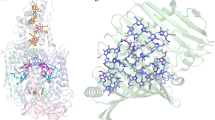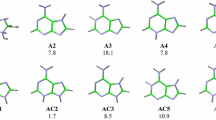Abstract
The relationship between the nature of the reactive triplet state of phenazine, as well as its mono-, di-, and tetrabenzo derivatives, and their reactivity in the formation of triplet exciplexes with amines has been investigated. It has been shown that the reactivity of triplet excited states of phenazines is determined mainly by the presence of vibrational mixing of the lower T1 and T2 triplet states with different electronic configurations (of the nπ* or ππ* type) and the position of the T2 level. The total reaction rate is determined by the sum of the rates of the processes with the participation of the T1 and T2 states.
Similar content being viewed by others
Literature cited
V. V. Osipov, M. N. Usacheva, and I. I. Dulung, “Kinetics of the complexation of excited molecules of phenazine and its benzo derivatives with dimethylaniline,” Khim. Vys. Énerg., 15, No. 3, 234–237 (1981).
V. V. Osipov, M. N. Usacheva, and I. I. Dilung, “Kinetic investigation of triplet exciplexes with an electron donor,” Dokl. Akad. Nauk SSSR, 254, No. 2, 407–410 (1980).
V. V. Osipov, M. N. Usacheva, and I. I. Dilung, “Vibronic coupling of triplet electronic states of different orbital nature in phenazine and its mono-, di-, and tetrabenzo derivatives,” Dokl. Akad. Nauk UkrSSR, Ser. B, No. 3, 45–48 (1984).
V. V. Osipov, M. N. Usacheva, and I. I. Dilung, “Excited complexes of phenazine and its benzo derivatives with dimethylaniline,” Teor. Éksp. Khim., 14, No. 5, 703–708 (1978).
H. Yoshinori and T. Ikuro, “Interconversion on the lowest triplet state of phenazine induced by excited picosecond impulse,” Chem. Phys. Lett., 43, No. 3, 568–570 (1976).
W. R. Ware, D. Watt, and J. D. Holmes, “Exciplex photophysics. 1. The α-cyanonaphthalene-olefin system,” J. Am. Chem. Soc., 96, No. 26, 7853–7860 (1974).
T. Shida and W. H. Homill, “Molecular ions in radiation chemistry. 1. Formation of aromatic-amine cations in CCl4 by resonance charge transfer at 77 K,” J. Chem. Phys., 44, No. 6, 2369–2374 (1966).
D. Rehm and A. Weller, “Bindungszustand und Fluoreszenzspektren von Hetero-Excimeren mit Abbildungen,” Z. Phys. Chem. Neue Folge, 69, No. 1/2, 183–200 (1970).
J. K. Roy, F. A. Carrol, and D. G. Whitten, “Spectroscopic studies of formation and decay of triplet exciplexes. Evidence for a limited role of charge-transfer interaction in a nonpolar solvent,” J. Am. Chem. Soc., 96, No. 20, 6349–6355 (1974).
A. Weller, “Singlet- and triplet-state exciplexes,” in: The Exciplex, Academic Press, New York (1975), pp. 23–36.
P. J. Wagner, A. E. Kemppainen, and H. N. Schott, “Effect of ring substituents on the type II photoreactions of phenyl ketones. How interactions between nearby excited triplets effect chemical reactivity,” J. Am. Chem. Soc., 95, No. 17, 5604–5614 (1973).
M. Berger, B. McAlpine, and C. Steel, “Substituted acetophenones. Importance of activation energies in mixed state models of photoreactivity,” ibid., 100, No. 16, 5147–5151 (1978).
K. Brenner, Z. Ruziewicz, G. Suter, and P. Wild, “The structure of low-temperature electronic spectra of benzo [a] phenazine,” Chem. Phys., 59, No. 1, 157–167 (1981).
F. A. M. Tavares, On the intermolecular interaction in π-exciplexes of aromatic hydrocarbons with amines,” J. Chem. Phys., 72, No. 1, 43–47 (1980).
Author information
Authors and Affiliations
Additional information
Translated from Teoreticheskaya i Éksperimental'naya Khimiya, Vol. 22, No. 3, pp. 291–296, May–June, 1986.
Rights and permissions
About this article
Cite this article
Osipov, V.V., Usacheva, M.N. & Dilung, I.I. Role of the vibrational coupling of 3nπ* and 3ππ* states in reactions resulting in the formation of triplet exciplexes of phenazine compounds with dimethylaniline. Theor Exp Chem 22, 273–277 (1986). https://doi.org/10.1007/BF00521152
Received:
Issue Date:
DOI: https://doi.org/10.1007/BF00521152




